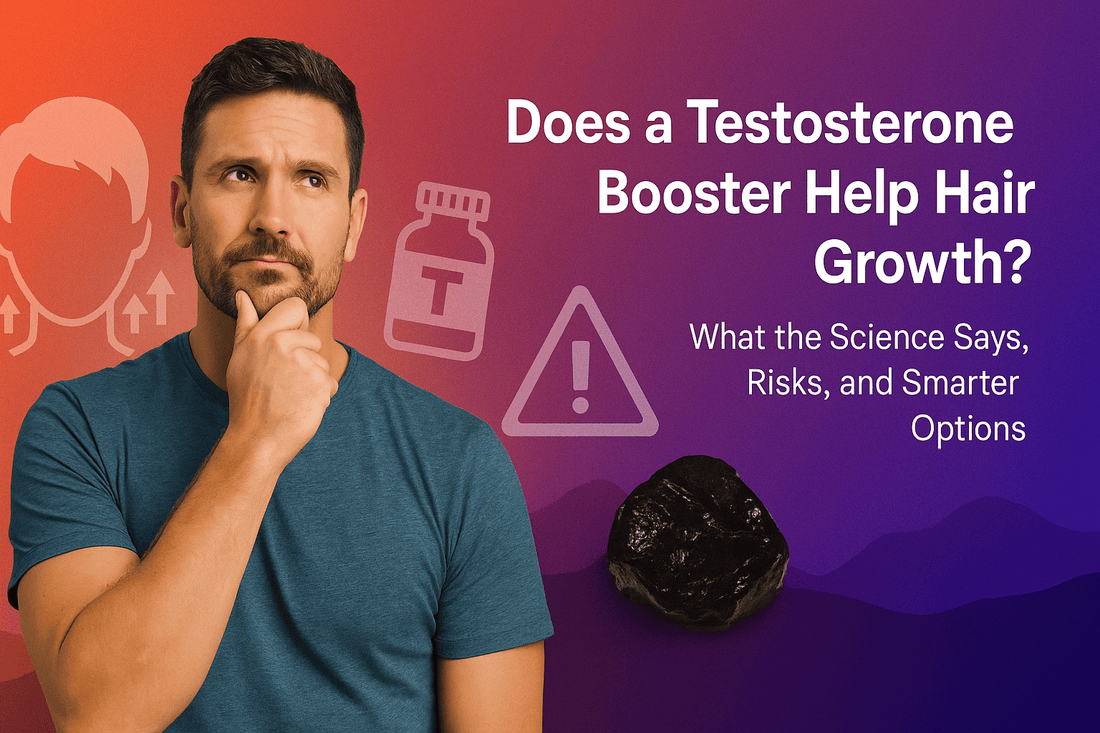
Does a Testosterone Booster Help Hair Growth? — What the Science Says, Risks, and Smarter Options
Share
Quick Answer
- For most men with pattern hair loss, raising testosterone is unlikely to regrow scalp hair and may even accelerate loss by increasing DHT, the androgen that miniaturizes susceptible follicles.
- Exceptions: If you’re deficient in nutrients (e.g., vitamin D, zinc) that affect hair biology, correcting those may help overall hair quality—this is different from “boosting T.”
- Women: Androgen-raising products can worsen female-pattern hair thinning or cause unwanted hair growth (hirsutism). See a clinician first.
- Treatments that lower DHT (5-alpha-reductase inhibitors) or stimulate follicles (minoxidil) are what consistently help scalp hair in clinical studies—not generic “testosterone boosters.”
Hair biology in 60 seconds
- DHT (dihydrotestosterone) is made from testosterone by 5-alpha-reductase. In genetically susceptible scalps, DHT shrinks follicles (miniaturization), shortening the growth phase and producing thinner hairs.
- That’s why DHT-lowering meds (e.g., finasteride/dutasteride) can slow or reverse male pattern hair loss, while just raising testosterone often does not.

Science explained simply
- Testosterone: Essential for male health, but not directly causing hair loss.
- DHT (dihydrotestosterone): Derived from testosterone, it shrinks scalp follicles in men with genetic sensitivity → thinning and baldness.
- Testosterone boosters: Often work by fixing deficiencies (zinc, vitamin D, magnesium, shilajit, ashwagandha). These improve energy, stamina, mood but don’t block DHT.
Many men search for “testosterone boosters for hair” because:
- They want energy, muscle, and vitality without losing hair.
- They’ve heard testosterone affects DHT (the hormone linked to male-pattern baldness).
- Some think boosting testosterone = thicker hair, while others fear it = baldness.

FAQ
Does a testosterone booster regrow scalp hair?
Usually no. In AGA-prone scalps, higher T can mean higher DHT, which worsens miniaturization. Follicle stimulators and DHT-lowering approaches are the evidence-based route.
Why do some men say they lost hair on TRT?
TRT can raise DHT, and if you’re genetically susceptible, thinning can accelerate—even as beard/body hair grows.
Can women use testosterone boosters for hair?
Generally no—androgen-raising can worsen female pattern thinning. Women should see a dermatologist for female-specific options.
What actually helps hair?
For pattern loss: DHT-control and follicle stimulation. For non-pattern shedding: correct deficiencies, manage stress, optimize sleep/protein.
Conclusion
- Testosterone boosters are not hair-growth treatments. In AGA-prone people they may worsen thinning by pushing more T → DHT.
- Focus on proven hair pathways (DHT control + follicle stimulation). If you still want T-support for energy or drive, choose measured, COA-verified products and keep your hair plan in place.
- For a balanced approach, consider Vedaeon Testosterone Booster for stamina/drive and Vedaeon Shilajit as a base—while managing hair via dermatologist-advised options.


